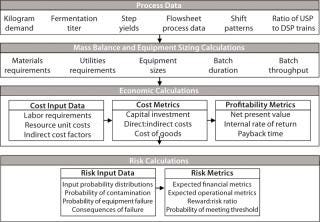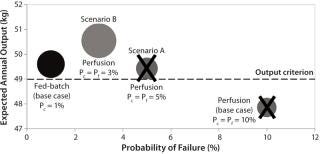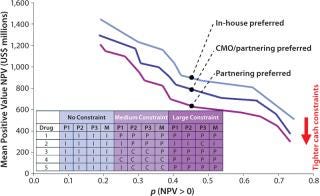Voices of Biotech
Podcast: MilliporeSigma says education vital to creating unbreakable chain for sustainability
MilliporeSigma discusses the importance of people, education, and the benefits of embracing discomfort to bolster sustainability efforts.
December 1, 2013
As the biotech sector has matured, it has come under increasing economic and regulatory pressures for continuous improvement in both drug development and manufacturing. As a result, assessing the value potential of alternative strategies has become critical to decision-making in areas such as bioprocess and facility design, capacity sourcing, and portfolio selection. Related decisions typically involve large cash expenditures and thus have a direct bearing on the feasibility of business units and whole companies.

Making such decisions is complicated constraints such as regulatory requirements and budgets and to uncertainties such as doses and fermentation titers (Figure 1). The impact of these decisions, constraints, and uncertainties on key financial, operational, and risk metrics must be understood for companies to derive more meaningful and transparent evaluations. Here I summarize some systematic approaches developed at University College London (UCL) in the United Kingdom for addressing typical industry questions in drug development and manufacturing.
PRODUCT FOCUS: BIOPHARMACEUTICALS
WHO SHOULD READ: EXECUTIVES AND PROJECT MANAGERS
KEYWORDS: PROCESS ECONOMICS, COG, CAPA#CITY PLANNING, PRODUCTION, SINGLE-USE TECHNOLOGY, MANUFACTURING, OUTSOURCING, DECISION-SUPPORT TOOLS
LEVEL: ADVANCED

These approaches involve developing decision-support tools that encompass and integrate a broad range of techniques: process economics, simulation, risk analysis, optimization, operations research, and multivariate analysis. Advantages and insights gained from approaches established by our research are illustrated below through industrial case studies. I seek to illustrate how multiple outputs for each set of competing strategies can be visualized to facilitate decision making.
Scope of Research on Decisional Tools for the Biotech Sector: Our research at UCL focuses on developing systematic foundations to help companies make better decisions with inevitable uncertainty in process yields, doses, timing, clinical trials success rates, and market potential. Specifically, the scope of decision-support tools at the manufacturing and development levels can be broadly categorized as follows: process synthesis and facility design, capacity planning, and portfolio management. The following sections discuss key challenges that our research addresses.
Capturing Process Robustness Under Uncertainty
Early UCL research on decisional tools for the biotech sector demonstrated how to integrate models effectively for bioprocess economics, manufacturing logistics through discrete-event simulations, and uncertainties by Monte Carlo simulation to address industrially relevant investment decisions at both a process and facility level (1,2,3,4,5,6,7). Models facilitated rapid evaluation of manufacturing alternatives in terms of operational, financial, and risk metrics while accounting for the intrinsic complexities specific to biopharmaceutical manufacture. At the core of these tools were process economics models to determine cost of goods (CoG) and other cost metrics (Figure 2). The benefits of such an integrated approach have been demonstrated through a series of industrial case studies (1,2,3,4,5,6,7,8,9,10,11,12,13).

Fed-Batch or Perfusion Culture Strategies: Typical upstream process decisions include comparing fed-batch and perfusion culture strategies. Process-economic comparisons can yield different rankings based on several factors such as cell densities, titers, pooling strategies, scale, and assumed probabilities of failure.
Lim et al. illustrated the potential impact of batch failure on the process economics of whole bioprocesses relying on either fed-batch or internal spin-filter perfusion culture for commercial production of antibodies at the ~50-kg scale (3). Here we analyzed trade-offs between the lower productivities and higher up-front investments of fed-batch processes against the greater operational risks with perfusion processes. A risk-based, discrete-event prototype model was used to incorporate upstream and downstream operations as well as ancillary activities related to equipment preparation and regulatory compliance activities.
Interestingly, the deterministic simulation results (without risks) illustrated that both process strategies have similar CoG per gram at the ~50-kg scale, under the assumptions made in that particular case study. By contrast, because the perfusion option offers lower initial investment costs — and hence a higher projected net present value (NPV) — a deterministic analysis predicts that such an operation is more economically feasible than fed-batch. But when accounting for fluctuations in cell culture titer, step yields, and the likelihood of contamination and equipment failure, Monte Carlo simulation results demonstrated that the perfusion option had a lower reward/risk ratio, failed to meet the desired output criterion, and hence was infeasible.
The bubble plot in Figure 3 illustrates that conclusion with bubble sizes proportional to the reward/risk ratio for each strategy. Our analysis identified how low the probabilities of contamination and bioreactor failure due to filter fouling had to drop for the perfusion option to be more fav
orable than the fed-batch option (3). As Figure 3 shows, in this particular case, only a drop in failure rates from 10% to 3% would both meet the output criterion and offer a large-enough reward/risk ratio. That would require significant changes in operational philosophy or equipment design to improve process robustness and hence economic feasibility.

New perfusion reactor systems — such as alternating tangential flow (ATF) perfusion reactors from Refine Technology — aim to reach higher steady-state cell densities with lower failure rates and faster turnaround times from failures than older systems could offer. Further studies have illustrated how introduction of such new technologies offers the potential for perfusion systems to become more economically competitive and robust compared with fed-batch processes (9).
Reconciling Multiple Conflicting Outputs Under Uncertainty
The above example — where alternatives that failed to meet the throughput criterion were eliminated — provided a “satisficing” method for ranking options. It is particularly useful when there are only a couple of output criteria. However, as problems become larger with multiple goals including qualitative issues, methods that combine those into a single measure of attractiveness can be useful for decision making, as described below.
Stainless Steel and Single-Use Facilities for Clinical Manufacture: Farid and coworkers illustrate the application of multiple-criteria decision-making to a facility decision made by a company with a pipeline of monoclonal antibodies (MAbs) (1, 5, 6). The company needed to decide whether to take a chance on a completely disposable (single-use) facility or invest in a traditional stainless-steel based one or go for a hybrid option at the 200-L scale. Table 1 lists key financial and operational criteria we considered relevant. We incorporated softer concerns in addition to process-economic considerations. For example, we accounted for the fewer cleaning validation studies required by disposable facilities. Such efforts can be significant with membranes and chromatography resins in particular, for which the number of cycles over which materials can be used with confidence (with no deterioration in performance) must be demonstrated. In this study, we also accounted for additional validation studies needed to assess the effect of extractables leached from disposable materials and to demonstrate the integrity of such materials.
Table 1:

A probabilistic additive weighting technique was used to incorporate explicitly the effects of intangible trade-offs while expressing uncertainty in the input variables so that the final scores provided an indication of intrinsic risk. Both the financial and operational scores were standardized by converting them to a common dimensionless scale. The aggregate score depended on the weighting of those two scores.
Sensitivity spider plots in Figure 4 illustrate how different relative weightings — expressed as the operational to financial combination ratio (R) — affect ranking of the options for a facility supplying early and late-phase materials. If financial and operational scores are considered equally important (R = 1), then both hybrid and disposables facilities outperform stainless steel at 200-L scale for both early and late-stage production. If financial savings are assumed to be at least twice as important as operational benefits (R ≤ 0.5), then the disposable option starts to dominate in both cases. Conversely, if operational benefits are considered to be twice as important as financial savings (R = 2), then the rankings depend on the stage of development.

For early stage material, the hybrid option is preferred followed by the disposable and finally stainless steel option. In that case, the operational score is most heavily influenced by the scores of criteria related to construction time, project throughput, and operational flexibility because factors relating to speed and flexibility are typically considered more important early on. By contrast, for a company concentrating on manufacturing late-stage clinical trial material, the relative rankings of individual criteria would be different. Validation efforts, the degree of on-line fermentation control, ease of scale-up, and reliance on suppliers would all assume greater importance. Under such circumstances, probabilistic additive weighting predicts that the stainless steel option would be more competitive.
This holistic approach can be used to capture other less tangible (but important) issues that can influence the decision-making process. That allows managers to see how their priorities affect the resulting rankings.
Efficiently Searching Large Decision Spaces
As problem complexity increases, a larger number of possible permutations of options makes it difficult (or impossible) to examine them individually. In cases involving multiple decisions, constraints, and uncertainties, decision-makers need methods to efficiently search through these large decision spaces. Combined portfolio management and capacity planning problems are good candidates for application of such optimization techniques. Several decisions are required at each stage of product development — from laboratory to clinic to market — for each drug in the portfolio. UCL research has thus further developed the concept of integrating operational, business, and uncertainty models to address these decisions (e.g., 10,11,12,13,14).
Port
folio Management — Selection and Capacity Sourcing: George and Farid (12, 13) examined approaches for tackling the scenario of a medium-sized biotech company with a potential pipeline of 10 MAb candidates (each with its own clinical, technical, and commercial uncertainties) but no established GMP manufacturing capacity. The problem was characterized by several decisions in relation to portfolio selection, portfolio scheduling, and build-or-buy capacity-planning decisions across the different stages of the development cycle under different budgetary constraints. For build-or-buy decisions, using contract manufacturing organizations (CMOs) or partners to access capacity enables delaying large capital outlays while incurring a premium for services and/or royalty charges.
The problem can be represented as a string of multiple decisions (Figure 5), which creates a very large decision space (~1021 individual strategies). So we devised an evolutionary algorithm that harnessed the benefits of Bayesian networks to efficiently search through the many possible permutations while capturing the multiple uncertainties and constraints. That was linked to an evaluation model that captured finances, timeframes, risks, and dependencies involved in the manufacturing, research and development (R&D), and clinical activities during drug development to compute the value potential of each string. Optimization was driven by balancing two key objectives — expected positive NPV and likelihood of a positive NPV — derived using Monte Carlo simulations on each string of decisions under uncertainties in costs, commercial factors, and manufacturing capabilities, as well as phase-transition probabilities for clinical trials. Applied to the portfolio as each drug entered the development cycle, those NPV valuations provided measures of financial attractiveness and ability to generate a positive profit.

An optimal set of strategies can be represented using Pareto frontiers (Figure 6). In this portfolio management example, the company would ideally want to maximize both the expected NPV and the likelihood of a positive NPV, which is a sign of a worthwhile investment. However, the Pareto frontier illustrates that those two objectives are in conflict with one another and that higher rewards can be achieved only at the expense of higher risks. Deciding where to choose along the frontier depends on a company’s risk preference.

It is interesting to see how budgetary constraints affect corporate strategies relating to build-or-buy capacity decisions. Pareto frontiers are shown for three budget levels in Figure 6, with the change in corporate strategies for the central cluster of strategies on each frontier highlighted. In this case study, the tool predicted that, as constraints decrease the propensity to make profit, they encourage management of risk through outsourcing to CMOs and/or sharing capacity with partners. So the optimization outputs suggest that a company might commit to creating capacity as late as possible when it is limited by budgetary constraints.
Face the Future Head-on
Here I focused on systematic approaches to make good decisions earlier in the development cycle of biopharmaceuticals, a business sector that is rife with uncertainties. These approaches involve models that integrate bioprocess economics, manufacturing logistics, stochastic behavior, risks, multiple conflicting objectives, and combinatorial decisions. The illustrative examples tackle industrially relevant investment decisions for cost-effective bioprocess design under uncertainty as well as stochastic R&D portfolio management and capacity planning. I provide methods for visualizing financial implications and robustness of alternative solutions from the integrated models.
On the manufacturing level, insights from these approaches allow the most promising strategies to be prioritized for further exploration with scale-down (15) and eventually full-scale experimentation. That will become increasingly important with new, more complex macromolecules that do not adhere to generic platform processes. Ultimately, each decision-support tool here facilitates structured dialogue among key stakeholders across different company divisions during both building and analysis. That is enabled by crystallizing the trade-offs and uncertainties involved and providing transparent valuations in terms of financial, operational, and risk metrics. Hence, the decision-support tools provide a valuable method of evaluating alternative strategies to cope with future challenges.
This is adapted from a chapter titled “Evaluating and Visualising the Cost-effectiveness and Robustness of Biopharmaceutical Manufacturing Strategies” in the 2012 Wiley book, Biopharmaceutical Production Technology, edited by G. Subramanian — reproduced with permission from Wiley-VCH Verlag GmbH & Co. KGaA.
About the Author
Author Details
Corresponding author Suzanne S. Farid is associate professor (reader) in bioprocess systems engineering and codirector of the EPSRC Centre for Innovative Manufacturing in Emergent Macromolecular Therapies hosted by the Department of Biochemical Engineering at University College London, Torrington Place, London WC1E 7JE, UK; 44-20-7679-4415; [email protected].
1.) Farid, SS.
2.) Lim, AC. 2005. Application of a Decision-Support Tool to Assess Pooling Strategies in Perfusion Culture Processes Under Uncertainty. Biotechnol. Progr. 21:1231-1242.
3.) Lim, AC. 2006. A Computer-Aided Approach to Compare the Production Economics of Fed-Batch Versus Perfusion Culture. Biotechnol. Bioeng. 93:687-697.
4.) Mustafa, MA. 2006. Retrofit Decisions Within the Biopharmaceutical Industry: An EBA Case Study. Food Bioprod. Proc. 84:84-89.
5.) Farid, SS, J Washbrook, and NJ. Titchener-Hooker. 2005. Combining Multiple Quantitative and Qualitative Goals When Assessing Biomanufacturing Strategies Under Uncertainty. Biotechnol. Progr. 21:1183-1191.
6.) Farid, SS, J Washbrook, and NJ. Titchener-Hooker. 2005. Decision-Support Tool for Assessing Bio-Manufacturing Strategies Under Uncertainty: Stainless Steel Versus Disposable Equipment for Clinical Trial Material Preparation. Biotec
hnol. Progr. 21:486-497.
7.) Farid, SS, J Washbrook, and NJ Titchener-Hooker. 2007. Modelling Biopharmaceutical Manufacture: Design and Implementation of SIMBIOPHARMA. Comput. Chem. Eng. 31:1141-1158.
8.) Stonier, A. 2012. Decisional Tool to Assess Current and Future Process Robustness in an Antibody Purification Facility. Biotechnol. Progr. 28:1019-1028.
9.) Pollock, J, SV Ho, and SS Farid. 2013. Fed-Batch and Perfusion Culture Processes: Operational, Economic and Environmental Feasibility Under Uncertainty. Biotechnol. Bioeng. 110:206-219.
10.) Rajapakse, A, NJ Titchener-Hooker, and SS Farid. 2005. Modelling of the Biopharmaceutical Drug Development Pathway and Portfolio Management. Comput. Chem. Eng. 29:1357-1368.
11.) Rajapakse, A, NJ Titchener-Hooker, and SS Farid. 2006. Integrated Approach to Improving the Value Potential of Biopharmaceutical R&D Portfolios While Mitigating Risk. J. Chem. Technol. Biotechnol. 81:1705-1714.
12.) George, ED, and SS Farid. 2008. Stochastic Combinatorial Optimisation Approach to Biopharmaceutical Portfolio Management. Industr. Eng. Chem. Res. 47:8762-8774.
13.) George, ED, and SS Farid. 2008. Strategic Biopharmaceutical Portfolio Development: An Analysis of Constraint-Induced Implications. Biotechnol. Progr. 24:698-713.
14.) Lakhdar, K. 2007. Multiobjective Long Term Planning of Biopharmaceutical Manufacturing Facilities. Biotechnol. Progr. 23:1383-1393.
15.) Titchener-Hooker, NJ, P Dunnill, and M Hoare. 2008. Micro Biochemical Engineering to Accelerate the Design of Industrial-Scale Downstream Processes for Biopharmaceutical Proteins. Biotechnol. Bioeng. 100:473-487.
You May Also Like